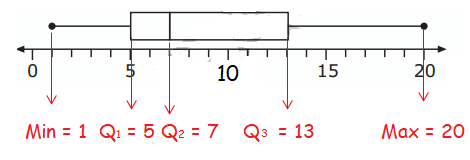6th GRADE EOG MATH PRACTICE PROBLEMS
Subscribe to our ▶️ YouTube channel 🔴 for the latest videos, updates, and tips.
Problem 1 :
Joe will go to the swimming pool on 20 different days this month.
- A one-day pass to the pool is $2.25.
- A monthly pass to the pool is $30.00.
How much money will Joe save by buying a monthly pass?
A) $20 B) $18 C) $15 D) $12
Solution :
Cost of one day pass = $2.25
Cost for 20 days = 20(2.25)
= 45
Cost of monthly pass = $30
The amount that Jill will save = 45 - 30
= $15
So, option C is correct.
Problem 2 :
A rectangular parking lot has an area of 2/3 of a square kilometer. The width is 1/2 of a kilometer. What is the length, in kilometers, of the parking lot?
A) 1/3 B) 2/3 C) 1 1/3 D) 1 2/3
Solution :
Area of rectangular parking = 2/3 square kilometer
Width = 1/2 kilometer
Length = L
Length x width = 2/3
(1/2) x L = 2/3
L = (2/3) / (1/2)
L = 4/3
Converting into mixed fraction, we get
L = 1 1/3
So, option C is correct.
Problem 3 :
The price of a theater ticket increased from $7.50 to $7.75. The theater sold 315 tickets at the higher price. With the price increase, how much more did the theater earn on the tickets?
A) $78.00 B) $78.25 C) $78.50 D) $78.75
Solution :
Difference in cost = 7.75 - 7.50
= 0.25
Cost of 315 tickets with difference amount = 0.25 (35)
= 78.75
So, answer option D is correct.
Problem 4 :
Hannah babysits to earn money.
- She charges $6.50 to babysit for the first hour.
- She charges $5.75 for each additional hour.
- Let n equal the number of hours after the first hour.
Which expression represents how much Hannah charges?
A) 12.25n B) 6.50 + 5.75n
C) 6.50n + 5.75 D) 6.50n + 5.75n
Solution :
Charges for first hour of babysit = $6.50
Hourly charges for the next hours = 5.75 n
So, total charge = 6.50 + 5.75n
Option B is correct.
Problem 5 :
What is the value of (1/7)3 ?
A) 3/7 B) 1/7 C) 3/343 D) 1/343
Solution :
(1/7)3 = (1/7) x (1/7) x (1/7)
= 1/343
So, option D is correct.
Problem 6 :
Which choice shows a set of data that could be represented by the box plot shown below?

A) 1, 3, 5, 6, 7, 7, 8, 13, 19, 20
B) 1, 3, 5, 6, 6, 8, 13, 14, 19, 20
C) 1, 2, 3, 5, 7, 8, 8, 13, 19, 20
D) 1, 5, 5, 6, 6, 6, 8, 13, 19, 20
Solution :

Option A :
1, 3, 5, 6, 7, 7, 8, 13, 19, 20
Minimum = 1
|
1, 3, 5, 6 Q1 = (3 + 5)/2 ==> 4 |
8, 13, 19, 20 Q3 = (13 + 19)/2 ==> 16 |
Median = 7
So, option A is correct.
Problem 8 :
A rectangular room has an area of 131 1/4 square feet. The length of the room is 12 1/2 feet. What is the width, in feet, of the room?
Solution :
Problem 9 :
Allen is building birdhouses that require 1/2 -ft-long boards. How many pieces that are exactly 1/2 ft long can be made from a board that is 8 1/4 ft long?
Solution :
So, 16 pieces.
Problem 10 :
How much money should John get back when he uses $10.00 to pay for purchases totaling $5.25?
Express the answer as dollars. cents.
Solution :
Amount John pays = 10
Value of purchasing = 5.25
= 10 - 5.25
= 4.75
Subscribe to our ▶️ YouTube channel 🔴 for the latest videos, updates, and tips.
Recent Articles
-
Finding Range of Values Inequality Problems
May 21, 24 08:51 PM
Finding Range of Values Inequality Problems -
Solving Two Step Inequality Word Problems
May 21, 24 08:51 AM
Solving Two Step Inequality Word Problems -
Exponential Function Context and Data Modeling
May 20, 24 10:45 PM
Exponential Function Context and Data Modeling